Thursday, April 2nd 2020

Intel 10th Gen Core "Comet Lake-H" Mobile Processor Lineup with Desktop-class Performance Announced: 5.3 GHz, 8 Cores, 16 Threads
Intel today announced its 10th generation Core "Comet Lake-H" mobile processor family with a promise of bringing premium desktop-level performance to conventional notebook form-factors, including some bordering the thin-and-light form-factors (under 2 cm thickness). The higher-end of the lineup is geared not just toward serious gaming and creative work, but also toward PC enthusiasts wanting to overclock the processors. For gamers, Intel is guiding its notebook partners to come up with new designs with high refresh-rate and DisplayHDR 1000 displays. The company is also providing OEMs with engineering support to better design their cooling solutions for these processors.
Compared to 9th generation "Coffee Lake-H" processors, the strategy with "Comet Lake-H" appears to be increasing clock-speeds at given price-points, along with introduction of Turbo Boost Max 3.0 technology to this segment, over from the company's HEDT processor lineup. Four out six SKUs hit the magic frequency figure of 5.00 GHz. Two of the SKUs even feature CPU overclocking support. The Core i5 family consists of 4-core/8-thread chips. The Core i7 lineup consist of two 6-core/12-thread parts, and one 8-core/16-thread part. The sole Core i9 SKU is an 8-core/16-thread, with the highest clock speeds and unlocked base-clock multiplier. The "Comet Lake-H" processors are built on 14 nm process, and have identical CPU IPC to "Skylake."The series begins with the Core i5-10300H and i5-10400H are 4-core/8-thread parts with 8 MB shared L3 caches. The i5-10300H is clocked at 2.50 GHz nominal with 4.50 GHz boost; while the i5-10400H ticks 100 MHz faster. The Core i7 lineup consists of three SKUs, the i7-10750H and i7-10850H being 6-core/12-thread parts with 12 MB L3 caches; and the i7-10875H being 8-core/16-thread with 16 MB L3 cache. The i7-10750H is clocked at 2.60 GHz with 5.00 GHz boost; while the i7-10850H runs at 2.70 GHz with 5.10 GHz boost.
The i7-10850H is "partially unlocked," in that you can manually overclock it by up to four "bins" (base clock multiplier values, i.e., by up to 400-ish MHz). The Core i7-10875H doesn't feature an unlocked multiplier, but is clocked at 2.30 GHz, with up to 5.10 GHz boost. Leading the pack is the Core i9-10980HK, clocked at 2.40 GHz nominal, 5.30 GHz boost, and a fully unlocked multiplier. Besides support for Extreme Tuning Utility (XTU), Intel is introducing a new tool that simplifies overclocking, called Speed Optimizer.
It's interesting to note that unlike previous-gen "Coffee Lake-H" series, "Comet Lake-H" chips only support conventional DDR4 SODIMM memory, with native support for DDR4-2933. LPDDR3 support is dropped, and there's no support for LPDDR4 or LPDDR4x replacing it, either. The processors support up to 128 GB of dual-channel memory. Between "Comet Lake-H" and AMD "Renoir," there are quite a few platform tradeoffs. Renoir supports LPDDR4X up to 4266 MHz dual-channel, PCIe gen 4.0, AMD's equivalent of Smart Sound technology (ability to give voice-commands even when the notebook is standing by), and a more advanced power-management solution. Intel's platform-level advantages are solely in the area of PCIe, with 40 total gen 3.0 lanes, which should enable multiple M.2 NVMe slots, Thunderbolt 3 ports, etc.On the platform side of things, not a lot has changed. The HM470 chipset is the core logic of choice. Combined with the 16 PCIe gen 3.0 lanes from the processor, the chipset puts out 24 gen 3.0 lanes of its own, totaling 40 on the platform. This enables notebooks to have multiple M.2 NVMe slots, more than one Thunderbolt 3 port, and other bandwidth-hungry onboard devices. Intel is standardizing 802.11ax Wi-Fi 6 (gig+) support using the company's new AX201 WLAN card. Some notebooks could even feature 2.5 GbE wired networking.
The complete slide-deck follows.
Compared to 9th generation "Coffee Lake-H" processors, the strategy with "Comet Lake-H" appears to be increasing clock-speeds at given price-points, along with introduction of Turbo Boost Max 3.0 technology to this segment, over from the company's HEDT processor lineup. Four out six SKUs hit the magic frequency figure of 5.00 GHz. Two of the SKUs even feature CPU overclocking support. The Core i5 family consists of 4-core/8-thread chips. The Core i7 lineup consist of two 6-core/12-thread parts, and one 8-core/16-thread part. The sole Core i9 SKU is an 8-core/16-thread, with the highest clock speeds and unlocked base-clock multiplier. The "Comet Lake-H" processors are built on 14 nm process, and have identical CPU IPC to "Skylake."The series begins with the Core i5-10300H and i5-10400H are 4-core/8-thread parts with 8 MB shared L3 caches. The i5-10300H is clocked at 2.50 GHz nominal with 4.50 GHz boost; while the i5-10400H ticks 100 MHz faster. The Core i7 lineup consists of three SKUs, the i7-10750H and i7-10850H being 6-core/12-thread parts with 12 MB L3 caches; and the i7-10875H being 8-core/16-thread with 16 MB L3 cache. The i7-10750H is clocked at 2.60 GHz with 5.00 GHz boost; while the i7-10850H runs at 2.70 GHz with 5.10 GHz boost.
The i7-10850H is "partially unlocked," in that you can manually overclock it by up to four "bins" (base clock multiplier values, i.e., by up to 400-ish MHz). The Core i7-10875H doesn't feature an unlocked multiplier, but is clocked at 2.30 GHz, with up to 5.10 GHz boost. Leading the pack is the Core i9-10980HK, clocked at 2.40 GHz nominal, 5.30 GHz boost, and a fully unlocked multiplier. Besides support for Extreme Tuning Utility (XTU), Intel is introducing a new tool that simplifies overclocking, called Speed Optimizer.
It's interesting to note that unlike previous-gen "Coffee Lake-H" series, "Comet Lake-H" chips only support conventional DDR4 SODIMM memory, with native support for DDR4-2933. LPDDR3 support is dropped, and there's no support for LPDDR4 or LPDDR4x replacing it, either. The processors support up to 128 GB of dual-channel memory. Between "Comet Lake-H" and AMD "Renoir," there are quite a few platform tradeoffs. Renoir supports LPDDR4X up to 4266 MHz dual-channel, PCIe gen 4.0, AMD's equivalent of Smart Sound technology (ability to give voice-commands even when the notebook is standing by), and a more advanced power-management solution. Intel's platform-level advantages are solely in the area of PCIe, with 40 total gen 3.0 lanes, which should enable multiple M.2 NVMe slots, Thunderbolt 3 ports, etc.On the platform side of things, not a lot has changed. The HM470 chipset is the core logic of choice. Combined with the 16 PCIe gen 3.0 lanes from the processor, the chipset puts out 24 gen 3.0 lanes of its own, totaling 40 on the platform. This enables notebooks to have multiple M.2 NVMe slots, more than one Thunderbolt 3 port, and other bandwidth-hungry onboard devices. Intel is standardizing 802.11ax Wi-Fi 6 (gig+) support using the company's new AX201 WLAN card. Some notebooks could even feature 2.5 GbE wired networking.
The complete slide-deck follows.

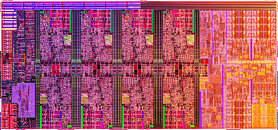
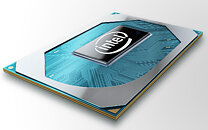
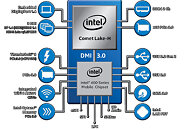

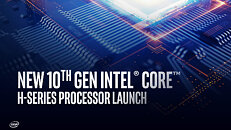

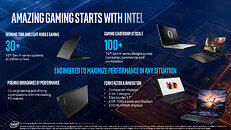



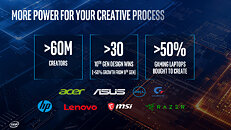









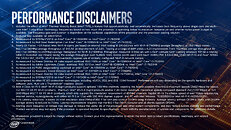

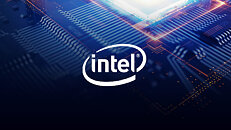
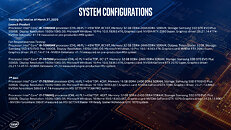

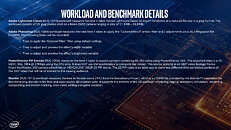
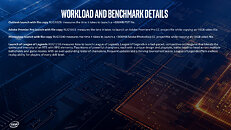
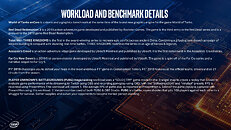

44 Comments on Intel 10th Gen Core "Comet Lake-H" Mobile Processor Lineup with Desktop-class Performance Announced: 5.3 GHz, 8 Cores, 16 Threads
And it would be fine if the prices reflected that, but it's Intel so you know it's gonna be overpriced
You can see it in the size, 2 cores 14nm Intel = 25mm2, 2 cores 7nm zen = 19mm2, really, really not that much big of a deal smaller.
Perhaps the unlocked CPU carries Z490, not H470.
Jerks ... they still have the nerve to sell parts that are 100 MHz apart from each other. What cost is involved in producing 100 MHz faster parts ? Nothing. All chips are sorted in the same testing process anyway and etched with the same number of characters anyway and packed into same packaging anyway ???
Jerks... They still don't get this "milking the customer by increasing CPU speed by 100 MHz" put them into this position. 5 years ago, they were claiming to be 18-24 months ahead of everybody in chip manufacturing process; now others , even AMD, are using 7 mm process and will move to 5 mm process soon; while they are still on 14 nm process.
They deserve what they will get.
Based on these specs, 6 and 8 core parts seem both to be produced as 8 core parts - and 6 core parts seem to be disabled cores after sorting process and core speeds are adjusted to use the unused thermal leeway . Did I say "Jerks" before ?
Also congratulations to Intel for now officially surpassing the 2x mark for boost clock vs. base clock. That is certainly impressive, but not in the way Intel wants it to be.
It really is too bad that the engineering effort to fit these into existing laptop designs will be trivial compared to designing new motherboards for Ryzen 4000-series chips, meaning we'll inevitably see far more laptops with these chips out there despite them being fundamentally inferior. Intel's massive marketing support of course doesn't help this either. But the ~2x delta in perf/W isn't going anywhere, meaning anything using these chips will be bigger, hotter, louder and no more performant (likely less) than AMD-equipped alternatives.Wait, is there something wrong with binning chips to reduce waste by disabling defective parts now? Please explain. I mean, this series is obviously not a match for Renoir, but binning like that is literally what everyone does. Do you think the <8 core AMD chips have different silicon? There is literally one Renoir die that is used across the entire U, H and HS lineups, regardless of core count, CU count and so on.
There just aren't going to be many laptops around featuring these CPUs (except for the i5s but those wont really be that much faster anyway). It's just something meant to steal the show.
Holy shit :135W in order to hit the 2 core maximum boost clocks in a laptop. What are they even doing at this point ?
The 4900HS has a ~65W boost for a short time, 55W boost for a longer time (a few minutes from reviews I've seen of the Asus G14) and then settles at 35W at ~3.5GHz for anything beyond that. These Intel chips will do the same, only the first number will be in the ~120-150W range, the second likely ~80, and the actual clock at TDP will be ~1GHz lower than AMD's. As for binning ... meh. These boosts will be so short as to make that a non-issue. Just feed it enough voltage and nearly any 14nm+++ chip can do 5.1GHz for a few seconds. It doesn't need more than that to reach Intel's (very misleading) spec.
As for i5s, try checking availability of 9th gen i5 H-series chips vs. i7s. There are far more SKUs with the latter, as Intel generally doesn't want OEMs to sell i5s with high end GPUs in the laptop space, so they cost essentially the same (or the purchase of the i7s comes with a bunch of rebates, engineering support, marketing support, etc.). The i7s will rule the roost despite being hot, slow, and generally sub-par. And that will apply for all of the 100+ H-series laptops Intel is announcing they have coming. There's no way on earth the majority of those will be i5s, and no way on earth AMD is getting anywhere near 100 designs for Renoir no matter how superior it is. Such is the power of being a market leader for a decade with massive coffers and strong ties to all OEMs. And the end user is the one who suffers.
Intel is cnn of marketing.